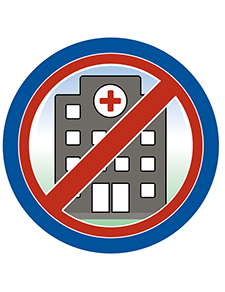Hospitalization Reduction
Reduce Hospital Admissions, Readmissions, and Outpatient Emergency Visits
Improving and Maintaining the Health of ESRD Patients
There are numerous reasons a dialysis patient may not be able to achieve and maintain optimal health. Health deficits may be related to health conditions, such as but not limited to, anemia, diabetes, cardiovascular disease, or diagnosed and undiagnosed mental health issues. Health deficits may be related to patient behavior, such as but not limited to, not taking medication as prescribed, failure to attend check-ups, eating an unhealthy diet, smoking tobacco, using recreational drugs, excessive alcohol use, lack of exercise, or missing or shortening dialysis treatment. Health issues may be related to an unstable social support system and/or financial problems, such as but not limited to, access to food, shelter, transportation, clothing, medication, medical care, and/or emotional support, making patients potentially unable to care for themselves.
Scroll down to view our listing of provider and patient resources.
Here are powerful tools and resources for healthcare providers to significantly reduce hospitalizations, prevent readmissions, and minimize emergency room visits. Discover how these resources can boost patient engagement, enhance knowledge, and help overcome common barriers. Check them out now to transform patient care.
GENERAL HOSPITALIZATION REDUCTION QUALITY IMPROVEMENT RESOURCES
TOOLS TO RUN AN EFFECTIVE QUALITY IMPROVEMENT PROJECT
Root Cause Analysis (RCA)
A root cause analysis is the process of discovering the reason or cause of a problem to identify an appropriate solution. To decrease hospitalizations, readmissions, and ER visits, your root cause will be the barrier that is preventing your facility from finding greater success with waitlist and transplant rates. View this video or read this guide to learn how to conduct a root cause analysis (RCA).
Plan-Do-Study-Act (PDSA)
Once you identify your root cause or barrier, you will then run a PDSA cycle. Running a PDSA cycle means you will plan out a test of change, carry out the test, observe, analyze, and determine if the change was successful, and then put the change into action or not. Utilize these worksheets to guide you through a PDSA cycle
RESOURCES FOR PROVIDERS AND PATIENTS
Patient
- *NEW* Staying on Track Series:
- Staying on Track: Still Making Urine English | Spanish
- *NEW* Managing Diabetes and Dialysis: English | Spanish
- Don't Miss a Minute: English | Spanish
- Healthy Feet Are Happy Feet English | Spanish
- We're Not Nosey, We Care! English | Spanish
- How Are you Feeling today? English | Spanish
- What Type of Care Do I Need? English | Spanish
- Help Avoid Hospitalizations Wallet Cards: English | Spanish
Provider
- Help Avoid Hospitalizations Wallet Cards: English | Spanish
- High Performers RCA/PDSA Cycle
- Sharing Your Successes and Processes
- Reducing Hospital Readmissions: Current Strategies and Future Directions
- Sepsis Healthcare Professional Handout
- Health Literacy Barriers and Strategies to Decreasing Acute Incidents (Recording) and (PDF Slides)
- Flashcards
- Hospitalization Risk Assessment Tool

